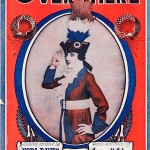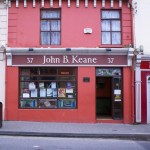In County Antrim, Ballygally Castle was constructed by Lord Shaw in 1625. He was rumored to have locked his wife, Lady Isobel Shaw, in her room and denied her food, until she threw herself out a window to her death. Ballygally Castle is now a chain hotel, and supposedly one of the most haunted places in Ireland, with Lady Shaw rumored to knock on doors and then vanish into the night.
Ballygally Castle
Mar 18th, 2018 by admin
Happy St. Patrick’s Day March 17
Mar 16th, 2018 by admin
An Irish blessing for St. Patrick’s Day:
May your blessings outnumber the shamrocks that grow,
And may trouble avoid you wherever you go.
Irish Drink – Cavan Cola
Mar 2nd, 2018 by admin
Introduced locally in Cavan, Ireland, in 1978, this dark cola had a dark brown, frothy head and a distinctive taste that set it apart from other sodas. Cavan Cola was so popular in the area that it went national in the early 1990s, becoming a nationwide phenomenon. In 1995, the business was bought by another company, who began phasing it out. By 2001, Cavan Cola had disappeared, even in Cavan, despite various online campaigns endeavoring to resurrect the beverage.
Gaelic Sports – Camogle
Feb 28th, 2018 by admin
Camogle is the version of hurling for female players. It is very similar to the male version, with some minor rule changes, such as a lack of special rules for goalkeepers, the allowance of hand passing, the use of a smaller ball (or sliothar), and a 60-minute game instead of a 70-minute one. Camogle players also generally wear skirts or skorts rather than shorts.
Christmas Newsletter 2017
Dec 1st, 2017 by admin
Click here for the latest news from our community groups in Northern Ireland Conway Mill Trust Christmas Newsletter 2017!
Happy Halloween!
Oct 31st, 2017 by admin
The origin of Halloween Games
Celts looked to the future at Samhain and could see ‘clues’ to the year ahead in the simplest things. Even peeling an apple could provide a clue to the name of a future wife or husband; if the peel was allowed to drop to the floor as it was peeled, it would form the initial letter of the lucky spouse. Apples also featured in the ‘ducking for apples’ game where the object is to retrieve an apple from a barrel or large bowl of water without using hands or feet. There was nothing particularly symbolic about the origin of Halloween games such as these. They are fun games in which all ages can participate, and apples were plentiful at this time of the year. Most other games and ‘rituals’ played out at Halloween were to do with courtship. Among them was the fortune-telling bowl of Colcannon. A ring (and sometimes a thimble, too) were mixed into a large bowl of this warming, simple dish which was placed in the middle of the table. Each person sitting around the table took a spoonful of the potato and cabbage mixture, dipping it into the well of melted butter at its centre. The person who found the ring was sure to be married within the year. The thimble denoted life without love and marriage. The origin of Halloween ‘trick or treating’ seems to have been a Druid ritual of collecting eggs, nuts and apples from the individual homes of the community. These offerings were meant to bring some protection from bad luck such as damage to crops or livestock in the next year. Those that were miserly in their offerings were likely to have a trick played on them. These pranks were harmless enough. They were intended to cause confusion ie changing the direction a gate opened. – See more at: http://www.irish-genealogy-toolkit.com/origin-of-Halloween.… he origin of Halloween games Celts looked to the future at Samhain and could see ‘clues’ to the year ahead in the simplest things. Even peeling an apple could provide a clue to the name of a future wife or husband; if the peel was allowed to drop to the floor as it was peeled, it would form the initial letter of the lucky spouse. Apples also featured in the ‘ducking for apples’ game where the object is to retrieve an apple from a barrel or large bowl of water without using hands or feet. There was nothing particularly symbolic about the origin of Halloween games such as these. They are fun games in which all ages can participate, and apples were plentiful at this time of the year. Most other games and ‘rituals’ played out at Halloween were to do with courtship. Among them was the fortune-telling bowl of Colcannon. A ring (and sometimes a thimble, too) were mixed into a large bowl of this warming, simple dish which was placed in the middle of the table. Each person sitting around the table took a spoonful of the potato and cabbage mixture, dipping it into the well of melted butter at its centre. The person who found the ring was sure to be married within the year. The thimble denoted life without love and marriage. The origin of Halloween ‘trick or treating’ seems to have been a Druid ritual of collecting eggs, nuts and apples from the individual homes of the community. These offerings were meant to bring some protection from bad luck such as damage to crops or livestock in the next year. Those that were miserly in their offerings were likely to have a trick played on them. These pranks were harmless enough. They were intended to cause confusion ie changing the direction a gate opened. – See more at: http://www.irish-genealogy-toolkit.com/origin-of-Halloween.…
Bluebells of Ireland
Oct 4th, 2017 by admin
George M. Cohan
Sep 30th, 2017 by admin
This year marked the 100th anniversary of the famous WWI song “Over There” by composer, lyricist and actor George M. Cohan. Cohan was born in Providence, R.I. on July 3rd, 1878 of Irish Immigrant parents from County Cork. The spelling of the family name was changed from Keohane to Cohan. George, who first appeared on the stage at age 8 received his many stage talents under the guidance of his parents and went on to become the first person from the world of arts and entertainment to receive the Congressional Gold Medal, one of the highest U.S. awards bestowed upon civilians for his composition of the songs ‘Over There’ and ‘A Grand Old Flag”. A U.S. Congressman from New York stated the Cohan was honored “because of his ability to instill in the hearts of the growing citizenry a loyal. and patriotic spirit for their country and what it stands for in the eyes of this world.” Cohan passed away on November 5th, 1942 but not before he was given a private showing of the movie “Yankee Doodle Dandy starring actor James Cagney in the role as Cohan. Cagney who also had Irish roots went on to win the Academy Award for best actor for his portrayal of Cohan. Famous quote-during the Gay Nineties he coined his famous curtain speech: “My mother thanks you, my father thanks you, my sister thanks you and I thank you.”





